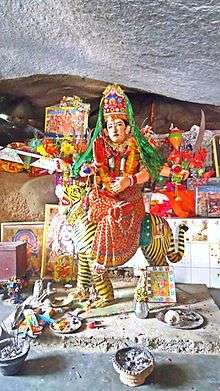Churrio Jabal
.jpg)
Churrio Jabal (چوڙيو جبل, pronunciation: choo-ryo ja-bal) is a hill, named Churrio, located in Taluka Nangarparkar, district Tharparkar @ Mithi, province of Sindh, Pakistan. A few scores from the Taluka headquarters, the hill is located at the outermost border of the country in the south-east of the province, surrounded by India from three sides, primarily famous for three things: the valuable multi-colored granite hill, the historical bangles' business and the temple of goddess Durga that attracts pilgrims from the international community following Hinduism.[1]
The name Churrio (Choryo)[2] is a word from Sindhi language, derived from a word (چوڙي), to be pronounced as (Choo-rree), which means 'a bangle'; thus the word Churrio--an adjective in Sindhi language--means "belonging to/related to bangles",[3] because in the vicinity of the hill there are a number of small villages that have historically remained attached to the profession of manufacturing bangles for women. These locally manufactured bangles are then transported out of the villages to the nearby towns like Nangarparkar up to Mithi in the west and Umerkot in the north. Accordingly, culturally, the women of the area dress in heavily embroidered clothes with bangles adorning their wrists.[4]

The Churrio Hill is formed of granite.[5] Compared to the neighbouring areas of Rajputana in India, which surround Tharparkar and Sindh, where the geological colour formation of granite is usually grey, the granite colour formation in Churrio, out of 8 to 10 varieties of pink and grey, is multicoloured; hence, pretty expensive, and is accordingly used in buildings, bridges, paving monuments and other exterior projects.[6]
On the top of this Churrio Hill is a temple of goddess Durga,[7] a goddess of Hinduism, attributed as destroyer of evil, triumph of good over evil, the mother of universe, and power behind the creation, preservation, and destruction of the world.[8] Owing to Durga's temple, thousands of pilgrims, not only from Pakistan, especially the provinces of Sindh, Baluchistan, Punjab and Khyber Pakhtunkhwa, but also from Nepal, India and other countries visit Churrio Hill for their religious festivals.[9] The temple is a part of Hindu religious and cultural heritage in Sindh, Pakistan. [10]
References
- ↑ http://www.sbi.gos.pk/pdf/granite-quarrying-project.pdf
- ↑ "Contractor blasting through Tharparkar temple in search of granite - The Express Tribune". 9 March 2011.
- ↑ Jam-e-Sindhi-Lughat/Sindhi-Language-Authority/2004
- ↑ Agencies (25 September 2014). "Hindus celebrate Navratri and Durga Puja festival".
- ↑ "Demographic, Social & Economic Changes in Tharparkar" (PDF).
- ↑ http://arifhasan.org/wp-content/uploads/2012/08/AH-007_comp-assessment-droughtandfamine.pdf
- ↑ "Pvt companys excavation threatens ancient Hindu temple in Pak".
- ↑ "Navaratri: The 9 Divine Nights".
- ↑ "In search of granite, path to Durga's temple blown up with dynamite".
- ↑ "Threat to Durga Mata Temple, Nangarparkar, Sindh".